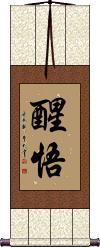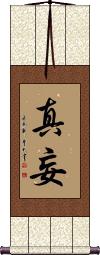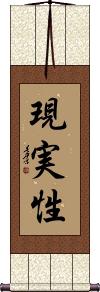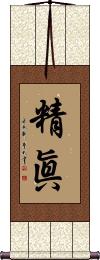Many custom options...
And formats...

Reality in Chinese / Japanese...
Buy a Reality calligraphy wall scroll here!
Personalize your custom “Reality” project by clicking the button next to your favorite “Reality” title below...
Honesty
Reality
醒悟 is a Chinese word that expresses the idea of reality or coming to understand what is true and real.
The first character means to wake up, awaken, comprehend, introspect, or visit.
The second character means to comprehend or understand (be enlightened).
The meanings of Chinese words are not necessarily the sum of their parts. In this case, at best, you can derive that the characters express “understanding what is real” or “knowing what is real.” Any Chinese person will perceive this word in a similar way to how we use “reality” in English.
![]() Note: The first character can also be written in a different form as shown to the right. Same meaning in Chinese, either way
it’s
written.
Note: The first character can also be written in a different form as shown to the right. Same meaning in Chinese, either way
it’s
written.
Reality and Illusion
Buddhism Concept
Reality and Illusion
Reality / Realistic
現実性 is a Japanese word that expresses the idea of reality or coming to understand what is true and real.
This can also be translated as realistic, practical, or feasible.
See Also: Illusion
Wake Up to Reality
Ultimate Reality
These search terms might be related to Reality:
Appreciation of Truth by Meditation
Comparison Leads to Truth and Enlightenment
Enlightened Truth
In Wine There is Truth
Knowledge of Ultimate Truth
Kyojitsu: Falsehood and Truth
Respect, Honor, Truth
Seeking Truth
The Supreme Mahayana Truth
Thirst for Truth
Triple Truth of Japanese Buddhism
True Religion / Buddha Truth
Truth
Truth Flashed Through the Mind
Truth Goodness and Beauty
Ultimate Truth
Not the results for reality that you were looking for?
Below are some entries from our dictionary that may match your reality search...
| Characters If shown, 2nd row is Simp. Chinese |
Pronunciation Romanization |
Simple Dictionary Definition |
体 see styles |
tai たい |
More info & calligraphy: Body / Karada |
定 see styles |
dìng ding4 ting jou / jo じょう |
More info & calligraphy: Samadhi(1) (See 案の定・あんのじょう) certainty; reality; actuality; (prefix noun) (2) (See 定宿) regular; permanent; (3) {Buddh} (See 三昧・さんまい・1,禅定・ぜんじょう・1) samadhi (state of intense concentration achieved through meditation); (given name) Yasushi To fix, settle. samādhi. 'Composing the mind'; 'intent contemplation'; 'perfect absorption of thought into the one object of meditation.' M. W. Abstract meditation, the mind fixed in one direction, or field. (1) 散定 scattered or general meditation (in the world of desire). (2) 禪定 abstract meditation (in the realms of form and beyond form). It is also one of the five attributes of the dharmakāya 法身, i. e. an internal state of imperturbability or tranquility, exempt from all external sensations, 超受陰; cf. 三摩提. |
實 实 see styles |
shí shi2 shih minoru みのる |
More info & calligraphy: Honesty(s,m) Minoru Real, true, honest, sincere; solid; fixed; full; to fill; fruit, kernel, effects; verily, in fact; it is used for 眞, as in 一實 the supreme fact, or ultimate reality; also for bhūta. |
空 see styles |
kòng kong4 k`ung kung kuu / ku くう |
More info & calligraphy: Sky / Ether / Void / Emptiness / Unreality(1) empty air; sky; (2) {Buddh} shunyata (the lack of an immutable intrinsic nature within any phenomenon); emptiness; (3) (abbreviation) (See 空軍) air force; (noun or adjectival noun) (4) fruitlessness; meaninglessness; (noun or adjectival noun) (5) (See 五大・1) void (one of the five elements); (can be adjective with の) (6) {math} empty (e.g. set); (female given name) Ron śūnya, empty, void, hollow, vacant, nonexistent. śūnyatā, 舜若多, vacuity, voidness, emptiness, non-existence, immateriality, perhaps spirituality, unreality, the false or illusory nature of all existence, the seeming 假 being unreal. The doctrine that all phenomena and the ego have no reality, but are composed of a certain number of skandhas or elements, which disintegrate. The void, the sky, space. The universal, the absolute, complete abstraction without relativity. There are classifications into 2, 3, 4, 6, 7, 11, 13, 16, and 18 categories. The doctrine is that all things are compounds, or unstable organisms, possessing no self-essence, i.e. are dependent, or caused, come into existence only to perish. The underlying reality, the principle of eternal relativity, or non-infinity, i.e. śūnya, permeates all phenomena making possible their evolution. From this doctrine the Yogācārya school developed the idea of the permanent reality, which is Essence of Mind, the unknowable noumenon behind all phenomena, the entity void of ideas and phenomena, neither matter nor mind, but the root of both. |
誠 诚 see styles |
chéng cheng2 ch`eng cheng masakatsu まさかつ |
More info & calligraphy: Honesty(adv,n) (1) truth; reality; (2) sincerity; honesty; integrity; fidelity; (3) (archaism) that's right (used when recalling forgotten information, suddenly changing the subject, etc.); (personal name) Masakatsu Truthful, true, truth; real; sincere, sincerity.; See under Fourteen Strokes. |
三諦 三谛 see styles |
sān dì san1 di4 san ti santai; sandai さんたい; さんだい |
More info & calligraphy: The Three TruthsThe three dogmas. The "middle" school of Tiantai says 卽空, 卽假. 卽中 i.e. 就是空, 假, 中; (a) by 空śūnya is meant that things causally produced are intheir essential nature unreal (or immaterial) 實空無; (b) 假, though thingsare unreal in their essential nature their derived forms are real; (c) 中;but both are one, being of the one 如 reality. These three dogmas arefounded on a verse of Nāgārjuna's— 因緣所生法, 我說卽是空 亦爲是假名, 亦是中道義 "All causally produced phenomena, I say, areunreal, Are but a passing name, and indicate the 'mean'." There are otherexplanations— the 圓教 interprets the 空 and 假 as 中; the 別教 makes 中 independent. 空 is the all, i.e. the totality of all things, and is spokenof as the 眞 or 實 true, or real; 假 is the differentiation of all thingsand is spoken of as 俗 common, i.e. things as commonly named; 中 is theconnecting idea which makes a unity of both, e.g. "all are but parts of onestupendous whole." The 中 makes all and the all into one whole, unifying thewhole and its parts. 空 may be taken as the immaterial, the undifferentiatedall, the sum of existences, by some as the tathāgatagarbha 如來藏; 假as theunreal, or impermanent, the material or transient form, the temporal thatcan be named, the relative or discrete; 中 as the unifier, which places eachin the other and all in all. The "shallower" 山外 school associated 空 and 中 with the noumenal universe as opposed to the phenomenal and illusoryexistence represented by 假. The "profounder" 山内 school teaches that allthree are aspects of the same. |
中道 see styles |
zhōng dào zhong1 dao4 chung tao nakamichi なかみち |
More info & calligraphy: The Middle WayThe 'mean' has various interpretations. In general it denotes the mean between two extremes, and has special reference to the mean between realism and nihilism, or eternal substantial existence and annihilation; this 'mean' is found in a third principle between the two, suggesting the idea of a realm of mind or spirit beyond the terminology of 有 or 無, substance or nothing, or, that which has form, and is therefore measurable and ponderable, and its opposite of total non-existence. See 中論. The following four Schools define the term according to their several scriptures: the 法相 School describes it as the 唯識, v. 唯識中道; the 三論 School as the 八不 eight negations, v. 三論; the Tiantai as 實相 the true reality; and the Huayan as the 法界 dharmadhātu. Four forms of the Mean are given by the 三論玄義. |
佛心 see styles |
fó xīn fo2 xin1 fo hsin busshin |
More info & calligraphy: Buddha Heart / Mind of BuddhaThe mind of Buddha, the spiritually enlightened heart. A heart of mercy; a heart abiding in the real, not the seeming; detached from good and evil and other such contrasts. |
無我 无我 see styles |
wú wǒ wu2 wo3 wu wo muga むが |
More info & calligraphy: Selflessness(1) selflessness; self-effacement; self-renunciation; (2) {Buddh} anatta; anatman; doctrine that states that humans do not possess souls; (female given name) Muga anātman; nairātmya; no ego, no soul (of an independent and self-contained character), impersonal, no individual independent existence (of conscious or unconscious beings, anātmaka). The empirical ego is merely an aggregation of various elements, and with their disintegration it ceases to exist; therefore it has nm ultimate reality of its own, but the Nirvāṇa Sūtra asserts the reality of the ego in the transcendental realm. The non-Buddhist definition of ego is that it has permanent individuality 常一之體 and is independent or sovereign 有主宰之用. When applied to men it is 人我, when to things it is 法我. Cf. 常 11. |
省悟 see styles |
xǐng wù xing3 wu4 hsing wu seigo / sego せいご |
More info & calligraphy: Wake Up to Reality(given name) Seigo to reflect and become aware |
真実 see styles |
shinjitsu(p); shinjichi(ok) しんじつ(P); しんじち(ok) |
More info & calligraphy: Truth |
精眞 see styles |
jīng zhēn jing1 zhen1 ching chen shōshin |
More info & calligraphy: Ultimate Reality |
般若 see styles |
bō rě bo1 re3 po je hannya はんにゃ |
More info & calligraphy: Great Wisdom(1) {Buddh} prajna (wisdom required to attain enlightenment); (2) {noh} (See 般若面・1) hannya; mask of a grinning, horned demoness (represents a woman's rage and jealousy); (3) (abbreviation) (See 般若面・2) dreadful face (esp. of a woman driven mad by jealousy); terrifying facial expression; (surname) Hanniya (般賴若) Prajñā is also the name of a monk from Kabul, A.D. 810, styled 三藏法師; tr. four works and author of an alphabet.; prajñā, 'to know, understand'; 'Wisdom. ' M. W. Intp. 慧 wisdom; 智慧 understanding, or wisdom; 明 clear, intelligent, the sixth pāramitā. The Prajñā-pāramitā Sutra describes it as supreme, highest, incomparable, unequalled, unsurpassed. It is spoken of as the principal means, by its enlightenment, of attaining to nirvana, through its revelation of the unreality of all things. Other forms 般羅若; 般諄若; 鉢若; 鉢剌若; 鉢羅枳孃; 鉢腎禳; 波若, 波賴若; 波羅孃; 班若. |
醒悟 see styles |
xǐng wù xing3 wu4 hsing wu |
More info & calligraphy: Reality |
波羅末陀 波罗末陀 see styles |
bō luó mò tuó bo1 luo2 mo4 tuo2 po lo mo t`o po lo mo to haramada |
More info & calligraphy: Paramartha |
大乘無上法 大乘无上法 see styles |
dà shèng wú shàng fǎ da4 sheng4 wu2 shang4 fa3 ta sheng wu shang fa daijō mujō hō |
More info & calligraphy: The Supreme Mahayana Truth |
不見棺材不落淚 不见棺材不落泪 see styles |
bù jiàn guān cai bù luò lèi bu4 jian4 guan1 cai5 bu4 luo4 lei4 pu chien kuan ts`ai pu lo lei pu chien kuan tsai pu lo lei |
More info & calligraphy: Do not shed a tear until you see the coffin |
世 see styles |
shì shi4 shih sei / se せい |
life; age; generation; era; world; lifetime; epoch; descendant; noble (counter) (1) counter for generations; (suffix noun) (2) {geol} epoch; (personal name) Toki yuga. An age, 1, 000th part of a kalpa.loka, the world. 世 originally meant a human generation, a period of thirty years; it is used in Buddhism both foryuga, a period of time ever flowing, andloka, the world, worldly, earthly. The world is that which is to be destroyed; it is sunk in the round of mortality, or transmigration; and conceals, or is a veil over reality. |
入 see styles |
rù ru4 ju shio しお |
to enter; to go into; to join; to become a member of; to confirm or agree with; abbr. for 入聲|入声[ru4 sheng1] (suf,ctr) (archaism) counter for soakings (of fabric in a dye); (surname) Kaeru To enter, entry, entrance; come, bring or take in; at home; awaken to the truth; begin to understand; to relate the mind to reality and thus evolve knowledge. |
境 see styles |
jìng jing4 ching sakae さかえ |
border; place; condition; boundary; circumstances; territory (1) border; boundary; (2) turning point; watershed; (3) area; region; spot; space; environment; (4) psychological state; mental state; (1) border; boundary; (2) area; region; spot; space; environment; (3) psychological state; mental state; (4) (Buddhist term) cognitive object; something perceptible by the sense organs or mind; (surname) Sakae viṣaya; artha; gocara. A region, territory, environment, surroundings, area, field, sphere, e.g. the sphere of mind, the sphere of form for the eye, of sound for the ear, etc.; any objective mental projection regarded as reality. |
如 see styles |
rú ru2 ju nyo にょ |
as; as if; such as {Buddh} (See 真如) tathata (the ultimate nature of all things); (female given name) Yuki tathā 多陀; 但他 (or 怛他), so, thus, in such manner, like, as. It is used in the sense of the absolute, the 空 śūnya, which is 諸佛之實相 the reality of all Buddhas; hence 如 ru is 賃相 the undifferentiated whole of things, the ultimate reality; it is 諸法之性 the nature of all things, hence it connotes 法性 faxing which is 眞實之際極 the ultimate of reality, or the absolute, and therefore connotes 實際 ultimate reality. The ultimate nature of all things being 如 ru, the one undivided same, it also connotes 理 li, the principle or theory behind all things, and this 理 li universal law, being the 眞實 truth or ultimate reality; 如 ru is termed 眞如 bhūtatathatā, the real so, or suchness, or reality, the ultimate or the all, i. e. the 一如 yiru. In regard to 如 ju as 理 li the Prajñā-pāramitā puṇḍarīka makes it the 中 zhong, neither matter nor nothingness. It is also used in the ordinary sense of so, like, as (cf yathā). |
実 see styles |
shí shi2 shih jitsu(p); jichi じつ(P); じち |
Japanese variant of 實|实 (noun - becomes adjective with の) (1) truth; reality; (noun - becomes adjective with の) (2) (じつ only) sincerity; honesty; fidelity; (noun - becomes adjective with の) (3) (じつ only) content; substance; (noun - becomes adjective with の) (4) (じつ only) (good) result; (m,f) Minoru |
梵 see styles |
fàn fan4 fan bon ぼん |
abbr. for 梵教[Fan4 jiao4] Brahmanism; abbr. for Sanskrit 梵語|梵语[Fan4 yu3] or 梵文[Fan4 wen2]; abbr. for 梵蒂岡|梵蒂冈[Fan4 di4 gang1], the Vatican (1) Brahman (ultimate reality of the universe in Hinduism); Brahma; (2) Brahma (Hindu creator god); (3) (abbreviation) (See 梵語) Sanskrit; (given name) Bon Brahman (from roots bṛh, vṛh, connected with bṛṃh, "religious devotion," "prayer," "a sacred text," or mantra, "the mystic syllable om"; "sacred learning," "the religious life," "the Supreme Being regarded as impersonal," "the Absolute," "the priestly or sacerdotal class," etc. M.W. Translit. |
諦 谛 see styles |
dì di4 ti tai たい |
to examine; truth (Buddhism) {Buddh} satya; truth; (given name) Tai To judge, examine into, investigate, used in Buddhism for satya, a truth, a dogma, an axiom; applied to the āryasatyāni, the four dogmas, or noble truths, of 苦, 集, 滅, and 道 suffering, (the cause of its) assembly, the ( possibility of its cure, or) extinction, and the way (to extinction), i.e. the eightfold noble path, v. 四諦 and 八聖道. There are other categories of 諦, e.g. (2) 眞 and 俗 Reality in contrast with ordinary ideas of things; (3) 空, 假 and 中 q.v. (6) by the 勝論宗; and(8) by the 法相宗.; Two forms of statement: (a) 俗諦 saṃvṛti-satya, also called 世諦, 世俗諦, 覆俗諦, 覆諦, meaning common or ordinary statement, as if phenomena were real; (b) 眞諦 paramartha-satya, also called 第一諦, 勝義諦, meaning the correct dogma or averment of the enlightened. Another definition is 王法 and 佛法, royal law and Buddha law. |
一如 see styles |
yī rú yi1 ru2 i ju ichinyo いちにょ |
to be just like oneness; (personal name) Kazuyuki The one ru, i.e. the bhūtatathatā, or absolute, as the norm and essence of life. The 眞如 true suchness, or true character, or reality; the 法性 nature of things or beings. The whole of things as they are, or seem; a cosmos; a species; things of the same order. Name of a celebrated monk, Yiru. V. 一眞; 一實. |
一実 see styles |
ichijitsu いちじつ |
{Buddh} the one absolute truth; the one reality; (personal name) Makoto |
一實 一实 see styles |
yī shí yi1 shi2 i shih ichijitsu |
The one reality; the bhūtatathatā; idem 一如, 一眞. |
一眞 see styles |
yī zhēn yi1 zhen1 i chen kazumasa かずまさ |
(personal name) Kazumasa The whole of reality, the universe, the all, idem 眞如; cf. 一如, 一實 bhūtatathatā. |
三印 see styles |
sān yìn san1 yin4 san yin san'in |
The three signs or proofs of a Hīnayāna sutra— non-permanence, non-personality, nirvāṇa; without these the sūtra is spurious and the doctrine is of Māra; the proof of a Mahāyāna sūtra is the doctrine of 一實 ultimate reality, q. v. Also 三法印. |
三宗 see styles |
sān zōng san1 zong1 san tsung mimune みむね |
(surname) Mimune The three Schools of 法相宗, 破相宗 , and 法性宗 q.v., representing the ideas of 空, 假, and 不空假, i.e. unreality, temporary reality, and neither; or absolute, relative, and neither. |
Click here for more reality results from our dictionary
The following table may be helpful for those studying Chinese or Japanese...
| Title | Characters | Romaji (Romanized Japanese) | Various forms of Romanized Chinese | |
| Honesty | 實 实 | shí / shi2 / shi | shih | |
| Reality | 醒悟 / 省悟 醒悟 | xǐng wù / xing3 wu4 / xing wu / xingwu | hsing wu / hsingwu | |
| Reality and Illusion | 真妄 | zhēn wàng zhen1 wang4 zhen wang zhenwang | chen wang chenwang |
|
| Reality and Illusion | 現実と幻想 | gen jitsu to gen sou genjitsutogensou gen jitsu to gen so | ||
| Reality Realistic | 現実性 | gen jitsu sei genjitsusei | ||
| Wake Up to Reality | 省悟 | shō go / shōgo | xǐng wù / xing3 wu4 / xing wu / xingwu | hsing wu / hsingwu |
| Ultimate Reality | 精眞 | shou shin / shoushin / sho shin | jīng zhēn jing1 zhen1 jing zhen jingzhen | ching chen chingchen |
| In some entries above you will see that characters have different versions above and below a line. In these cases, the characters above the line are Traditional Chinese, while the ones below are Simplified Chinese. | ||||
Successful Chinese Character and Japanese Kanji calligraphy searches within the last few hours...










